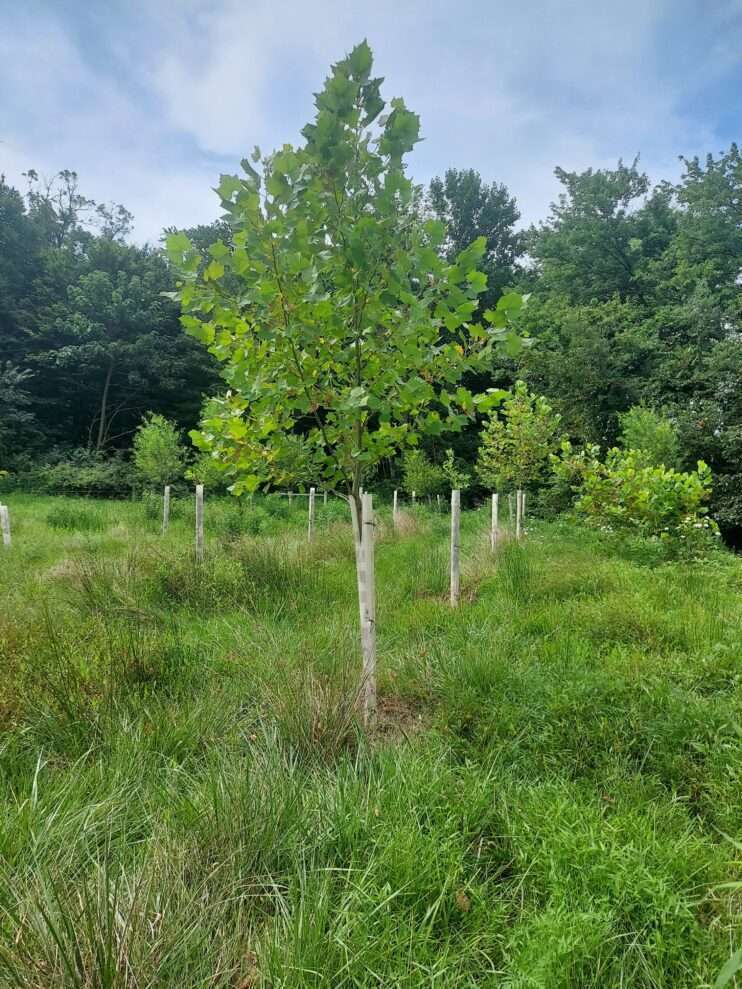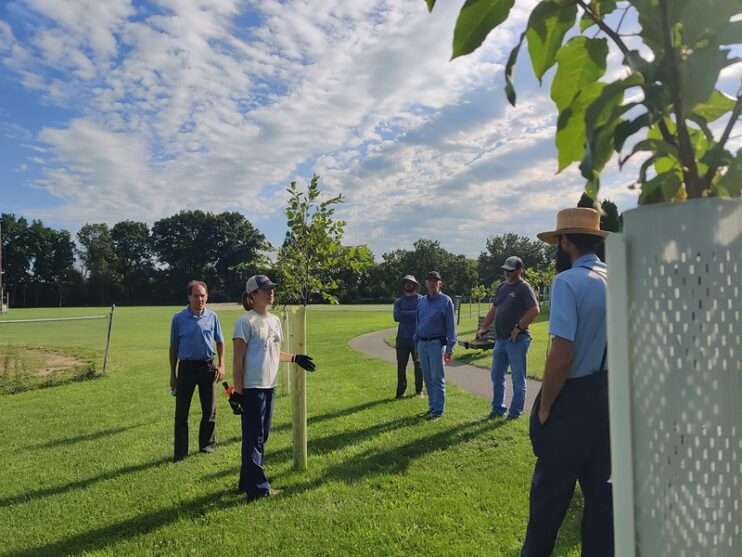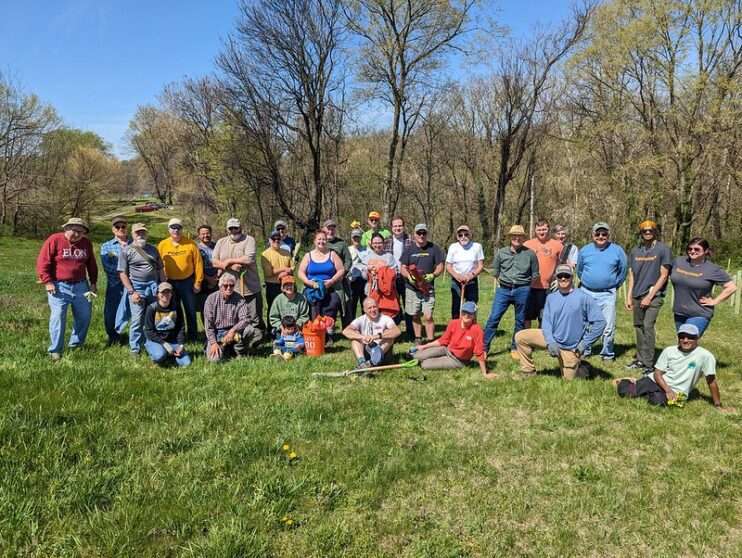Guest Blogger Rebecca Lauver
October 2nd 2023

This is what a standard Alliance tree planting looks like- 5 foot tree shelters, vegetation cleared around each shelter, and the area is mowed periodically. Photo credit: Rebecca Lauver
As riparian forest buffer plantings become increasingly prevalent, more and more folks are aware of what a successful tree planting looks like in the field. Having a maintenance plan in place, proper native species selection, and appropriate planting techniques are all more commonplace aspects of riparian forest buffers. However, as you drive by a young tree planting, you might not think about all of the behind the scenes work that goes into ensuring these plantings are done properly and will thrive over the long term.
Over the course of my three years working for the Alliance for the Chesapeake Bay, I’ve become immersed in the world of tree plantings and the logistics that go into getting them in the ground. To celebrate this year’s Riparian Buffer Month celebrations, I wanted to reflect on what I have found to be some of the important behind the scenes components of the Alliance’s work to establish riparian forest buffers. While specific techniques or program structures may differ from organization to organization, hopefully this recipe holds true for other organizations as well.
Partnerships
Partnership is a word that comes to mind first when I think about the work of the forest team at the Alliance. Partners can take on many different forms and roles from state agencies to smaller scale watershed volunteer groups. Conservation districts or local watershed organizations often have connections to volunteer groups and more localized resources that may not be as publicly known.
Other organizations also have partnership-oriented resources that can be integral to successful buffers. One prime example of this is the Chesapeake Bay Foundation’s Keystone 10 Million Trees program which provides free trees, stakes, and shelters. This is a crucial resource for the Alliance and has helped us to get many more acres of tree plantings completed.

For a tree maintenance day, the Alliance partnered with Belmont Solar to have their employees volunteer their morning to tend to the trees at the tree planting at Paradise Community Park. Photo Credit: Cathleen Anthony
Sharing best practices and insight from fellow partner’s tree plantings is yet another way that partnerships are important. Stroud Water Research Center conducts studies on different tree planting best practices like to remove tree shelters, what type of vegetation control is best around tree shelters, and how frequently to mow a site (just to name a few). Sharing what does and doesn’t work with one another helps everyone to have better success with their own plantings which furthers the mission of all of the organizations involved in this work.
Partnering with the community in reforestation work has also been beneficial to the Alliance’s work; we like to refer to the energy that volunteers bring to a planting event as “volunteer magic.” The enthusiasm and support that the general public adds to these reforestation efforts can make a huge difference.
Funding
Obviously, having the funds to pay for the staff time, contractors, and materials that are required to implement a tree planting is a necessity. The Alliance and many partner organizations rely on grants from the county, state, and federal level and grant writing is an important behind the scenes skill to unlock those funds. Many grants require matching funds as well which can come from volunteer time, other grant sources, or other non-grant sources of funding like private donations and fundraising.
Non-grant sources of financial support are extremely helpful because they may be used for costs that grants don’t typically cover. Having robust grant programs and funding support for the long term for tree plantings will continue to be an important element in their success.
Landowner buy-in and communication
While tree plantings need the approval of the land owner or manager of the property, those individuals don’t always want to be closely involved in the care of the trees afterwards. In most cases, this is fine! The trees will continue to grow and the maintenance of the site is normally contracted out anyway. But I’ve found that when possible, taking the extra step to ensure that the landowner is involved in the upkeep of it can go a long way to increase the success of the planting. Quick periodic check-ins with landowners can be very beneficial as this provides a time to see if there are any issues that need to be addressed and to make sure the trees are still doing well.

The Alliance worked with the Landisville Mennonite Church to do a tree planting on their property. Having the support of the church staff was crucial, especially when it came to getting volunteers out to plant the trees! Photo Credit: Rebecca Lauver
Additionally, having clear expectations about how the tree planting will change over time is crucial. The vegetation and ground cover within the tree planting area will most likely look different than it did prior to the planting; areas that were mowed as a lawn or grazed regularly may start to have taller herbaceous vegetation. In cases where this is a concern, it is important to keep in mind that the goal of the planting is to create a future forest and that the landscape will look a bit different. Easing up on mowing and getting more native vegetation along our streams goes a long way in improving the water quality.
Flexibility
Flexibility is both a behind the scenes skill and in-field skill that comes in to play a lot of tree plantings. Every site has its own unique concerns, landowner goals, and site conditions that have to be considered in the planning process. Site conditions may change over time as invasive species move in or flooding damages the buffer. In these instances, we may need to make changes to the maintenance plan for the site or planting plan. In non-field settings, flexibility can take many shapes as well, from shifting program structures due to funding changes to creating additional volunteer events to accommodate increased interest in tree plantings.

Pictured here is a volunteer group post-tree planting- this is where the “volunteer magic” comes into play! Photo Credit: Cathleen Anthony
The Wrap Up
These are just a few of the important behind the scenes elements that I’ve found to be helpful in the nonprofit world of tree plantings. Getting these tree plantings in the ground takes a whole village (watershed) of organizations!

Rebecca currently works as a Forests Projects Coordinator, based at the Alliance’s Lancaster office. She helps to implement tree plantings, coordinate volunteers, and further reforestation efforts within Pennsylvania. Rebecca graduated from Messiah University with a B.S. in Biology and an Ecology concentration. During college, she interned at Stroud Water Research Center for three summers in the entomology lab, working to measure water quality through the use of benthic macroinvertebrates.
After graduation, Rebecca joined the Alliance team for a one-year position through the Chesapeake Conservation Corps, where she worked with Alliance staff on our Forest team before joining the Alliance full-time in August 2021. Beyond the time spent outdoors for work, Rebecca also enjoys hiking, kayaking, and exploring the local landscape. She can frequently be found reading, drawing, or playing with her cat, Toph.


